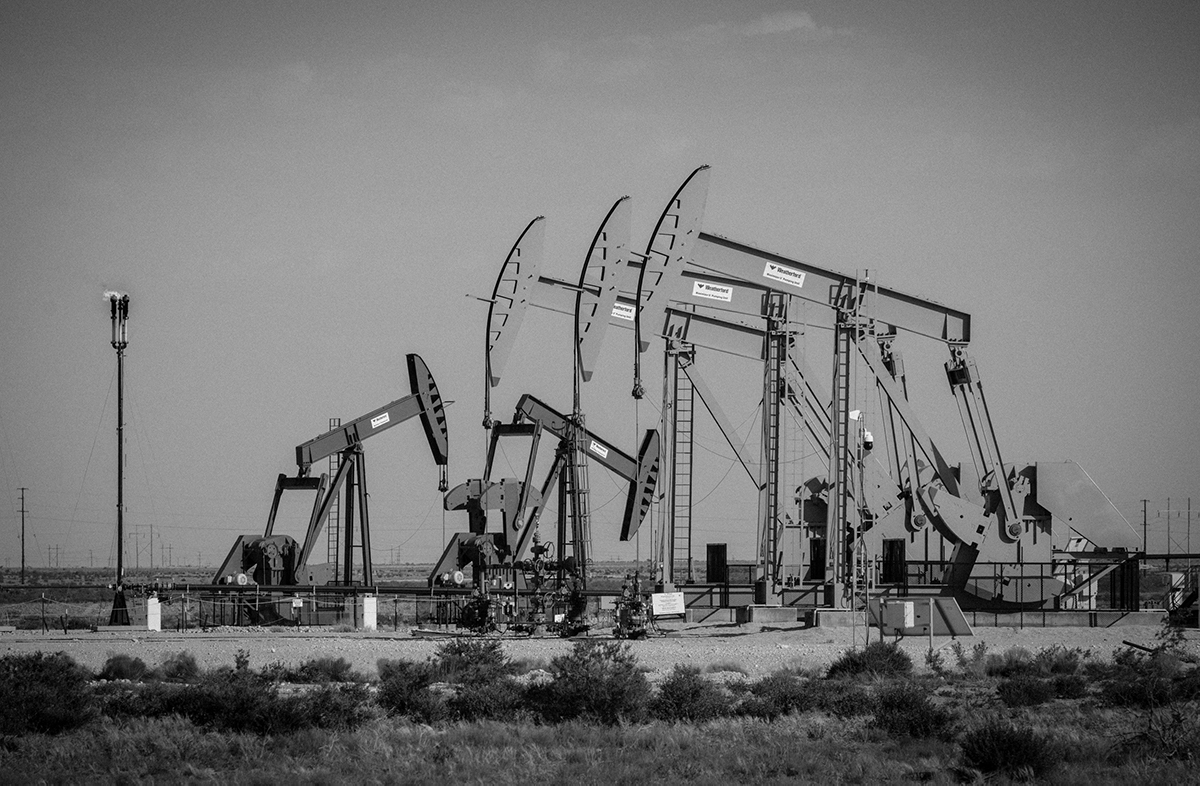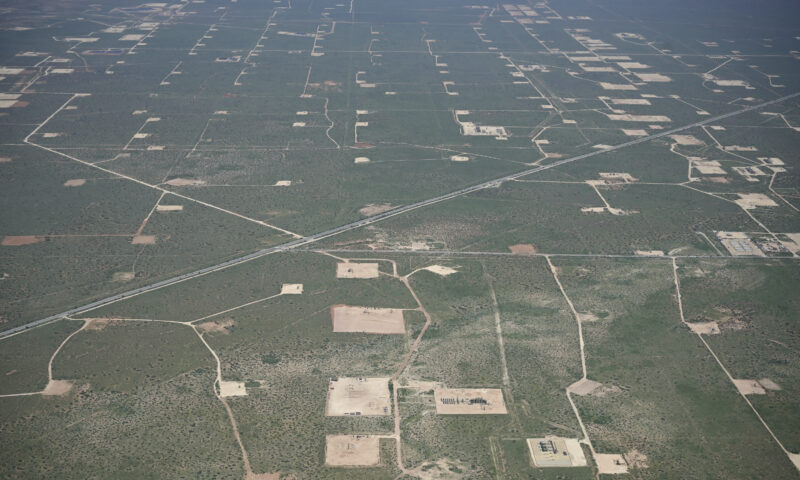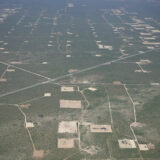The Slick
New Mexico Drilling Permits Skyrocketed Under Trump, State’s Climate Future at Risk
The drastic increase in permits comes at a time when climate science shows that new drilling and production should be winding down.

Over the past four years, oil and gas producers have applied for more than 10,000 permits to drill for oil and gas on federal land in New Mexico. Recent data provided to Capital & Main by the U.S. Bureau of Land Management (BLM) shows that Applications for Permit to Drill (APDs) slowly rose quarter by quarter from 2017 through the start of 2020, then more than doubled in the last half of the year. And just a few companies are behind the jump.
Co-published by the Santa Fe Reporter
“We’ve already locked in decades of warming and catastrophic climate change,” says Jesse Prentice-Dunn, policy director at the Center for Western Priorities. “And when these permits are drilled, we’re locking in decades more of it.”
He calls the number of permits “pretty much an all-time high.”
“Everyone I talk to can’t remember a statistic that large,” he says.
If the BLM approves all those permits, and companies use them within their four-year maximum time limits, it would increase the total number of active oil and gas wells in the state by roughly 20% in that time frame — and that is not counting any new wells on private, tribal or state lands. People who track the industry say that while these companies may not use all of these stockpiled permits, it’s also entirely possible they will.
The sale of mineral leases on federal land have been at the center of an ongoing brouhaha between President Biden’s administration and the oil and gas industry.
And if all of these permits are approved and used, the resulting wells would pose a major increase in fossil fuel production and carbon emissions at a time when climate science clearly shows that any new drilling and production should instead be winding down. Last Monday the Intergovernmental Panel on Climate Change (IPCC) released its Sixth Assessment Report, which states, “This Report reaffirms with high confidence the … finding that there is a near-linear relationship between cumulative (human-caused) CO2 emissions and the global warming they cause.”
Trey Cowan, an oil and gas analyst with the Institute for Energy Economics and Financial Analysis, says the dramatic increase in permits is “basically piling on ahead of the worry that they won’t be able to get them anymore” in light of possible future climate and environmental restrictions. And they piled on in the closing months of the extraction-friendly Trump administration.
* * *
APDs are the second critical bit of bureaucratic approval needed to drill on federal land. First, an operator buys a mineral lease, which allows a company to extract the oil and gas on a particular patch of ground. Those leases have been at the center of an ongoing brouhaha between President Biden’s administration and the oil and gas industry.
Soon after taking office, Biden paused the federal lease sales program to allow for a review of the process. Industry cried foul and said the pause hurt business, in spite of the fact that they had stockpiled thousands of leases that could keep drills spinning for years. Then, in June, a federal judge declared the pause illegal and called for lease sales to be restarted. This week, the Department of the Interior said that it would resume the leasing program while the Biden administration appeals the judge’s ruling.
While purchasers must begin production on leases within 10 years, drilling permits represent more imminent oil and gas activity. Under APDs, operators have two years to drill a well, with the possibility of a two-year extension.
According to the BLM records, 107 operators applied for APDs in New Mexico in the past four years. And the top five companies on that list applied for nearly 1,000 more drilling permits than the other 102 companies combined.
EOG Resources of Houston — already New Mexico’s largest oil and gas producer — has nearly 2,700 of those 10,000 APDs either approved or pending approval. In fact, it has more permit applications either approved or pending than the next five companies combined. Devon Energy of Oklahoma City — the state’s second-largest oil and gas producer — is a distant second with a little more than 1,100 permits either approved or pending.
When asked about EOG’s plans in New Mexico, its expectations for development in the future and its thoughts on the IPCC report, Kimberly Ehmer, a company spokesperson, wrote in an email, “We have been building a backlog of permits in the Delaware Basin for a number of years primarily to provide flexibility for future development planning as our operations in the basin expand over time.”
Oil and gas companies still see the near future powered by oil and gas, despite the increasingly clear and urgent reality that greenhouse gas emissions need to be brought down to zero.
Cowan says that while some of the smaller producers on the list might be gambling on whether or not the market and their land will bring them money, EOG is not “willy-nilly in how they do things. They’re very purposeful.”
He says, “EOG over the years has been a leader as far as operating margins. And the only way you get to have good operating margins is by selecting good rocks to drill and doing it cheaper than your peers.”
Tom Zelenka, a petroleum engineer with the BLM state office in Santa Fe, says that companies plan well in advance to have drilling permits lined up when leases approach their expiration dates. “They’re aware of their time periods, they’re aware of the expiration of leases and of wells,” he says.
These permits cost money — about $11,000 a pop — and companies aren’t collecting them by accident. Oil and gas companies still see the near future powered by oil and gas, despite the increasingly clear and urgent reality that greenhouse gas emissions need to be brought down to zero.
“The odds are this stuff’s going to get produced,” says Tom Singer, senior policy advisor at the Western Environmental Law Center.
When talking about companies like EOG and Devon, he says, “They’re not some prospector on the back of a mule with a pickaxe … They know where the good geology is. They’ve already bought it.”
And nearly all of the drilling permits are for the “good geology” they bought in the Permian Basin, where oil is trapped in layers of rock sitting one atop another in what’s called a “stack play.” That has helped turn the basin into the top oil-producing region in the country.
“It’s what makes it so juicy for these companies,” Singer says.
* * *
New Mexico also has a large, self-imposed role to play in monitoring and regulating the more than 53,000 active oil and gas wells already in the state. When she first came into office, Gov. Michelle Lujan Grisham pledged to reduce the state’s carbon footprint by 45% by 2030.
According to a report commissioned by the state, those wells and their associated transport and production operations leaked or burned the equivalent of 60 million metric tons of CO2 in 2018 — more than half of all greenhouse gases emitted in the state. It was roughly equal to the amount created by the whole state of Maryland as it drove its cars and lit its power plants that year — a state with nearly three times the population of New Mexico.
State regulatory agencies have new and pending rules to cut emissions, but they are still years away from being fully implemented. Adding another 10,000 or more wells to the state’s inventory before the monitoring rules are fully enforced could be a significant blow to the state’s emission reduction goals.
The timing is critical.
According to the authors of the IPCC report, limiting climate change requires limiting carbon emissions to “at least net zero” with “strong reductions” in other greenhouse gas emissions as soon as possible.
Already, temperatures have steadily risen in New Mexico since the 1970s, and even under a low-emissions scenario, the IPCC notes that the “likelihood of extreme droughts increases by 100% in southwestern North America.”
The permit application binge at the end of 2020 created a massive backlog at the Bureau of Land Management, with more than 3,300 applications still pending review.
Questions sent to the governor’s office about the 10,000 APDs, monitoring possibly thousands of new wells, and how such an increase would square with the governor’s environmental and greenhouse gas reduction goals were forwarded to the state’s Oil Conservation Division (OCD) and Environment Department (NMED).
In general, their response was that pending and recently enacted rules from the two agencies should protect the state from any future oil and gas development problems.
“The rules already enacted by [OCD] and in process from [NMED] were crafted to be long lasting and strong. New wells coming online must meet the strict requirements laid out in the natural gas capture rules, which prohibit routine venting and flaring, require 98% gas capture and additional reporting and monitoring through every step of the process,” they wrote.
They also wrote that the OCD rule was written “to be manageable for our staff and we are working to digitize and efficiently manage the additional reporting and monitoring needed.”
Singer is unconvinced that the rules are enough, or that they are being implemented quickly enough. For example, the 98% gas capture noted above happens in 2026 following years of incremental increases. He also says that the drilling permit bonanza should prod Gov. Lujan Grisham to increase oversight of the industry beyond the rules already in the pipeline and increase funding to OCD and NMED for increased oil field monitoring.
Currently, OCD reviews all permits approved by the BLM. And while the state agency cannot revoke the permits, it can require additional conditions and restrictions. But their staff is tiny: The BLM has 64 people checking applications in its Carlsbad office (which receives the overwhelming majority of New Mexico’s applications), while OCD has eight for the entire state.
They all have heavy workloads in front of them. Zelenka at the BLM says the agency tries to clear applications within 60 days — but like a pig in a python, the permit application binge at the end of 2020 created a massive backlog, with more than 3,300 applications still pending review.
Another key worry for scientists and regulators is methane — a key component of natural gas and often a fellow traveler with crude oil — leaking into the atmosphere from oil field operations. Even though it degrades over time, methane is a far more potent greenhouse gas than carbon dioxide. Adding more of it to the atmosphere at a time when such emissions need to drop is — at best — problematic for any environmental or greenhouse gas reduction goals.
Singer says that the state should close the loopholes allowing methane venting and flaring that happens during well drilling and completion processes, something that recent and pending rules from the two state agencies don’t completely cover.
“And if you’re looking at 10,000 new drills, that would be a very good thing to do, a very smart thing to do,” he says.
Copyright 2021 Capital & Main

-

 Latest NewsDecember 8, 2025
Latest NewsDecember 8, 2025This L.A. Museum Is Standing Up to Trump’s Whitewashing, Vowing to ‘Scrub Nothing’
-

 Striking BackDecember 4, 2025
Striking BackDecember 4, 2025Home Care Workers Are Losing Minimum Wage Protections — and Fighting Back
-

 The SlickDecember 2, 2025
The SlickDecember 2, 2025Utility Asks New Mexico for ‘Zero Emission’ Status for Gas-Fired Power Plant
-

 Dirty MoneyDecember 3, 2025
Dirty MoneyDecember 3, 2025Trump’s Anti-Climate Policies Are Driving Up Insurance Costs for Homeowners, Say Experts
-

 Child FarmworkersDecember 5, 2025
Child FarmworkersDecember 5, 2025To Protect Underage Farmworkers, California Expands Oversight of Field Conditions
-

 Column - State of InequalityDecember 4, 2025
Column - State of InequalityDecember 4, 2025Can California Claw Back Some Medi-Cal Care?
-

 Latest NewsDecember 10, 2025
Latest NewsDecember 10, 2025Capital & Main, L.A. Times Win Sidney Award for Reporting on Child Farmworkers
-

 StrandedDecember 9, 2025
StrandedDecember 9, 2025Giving Up on the Dream: Asylum Seekers Try Other Options in Mexico

